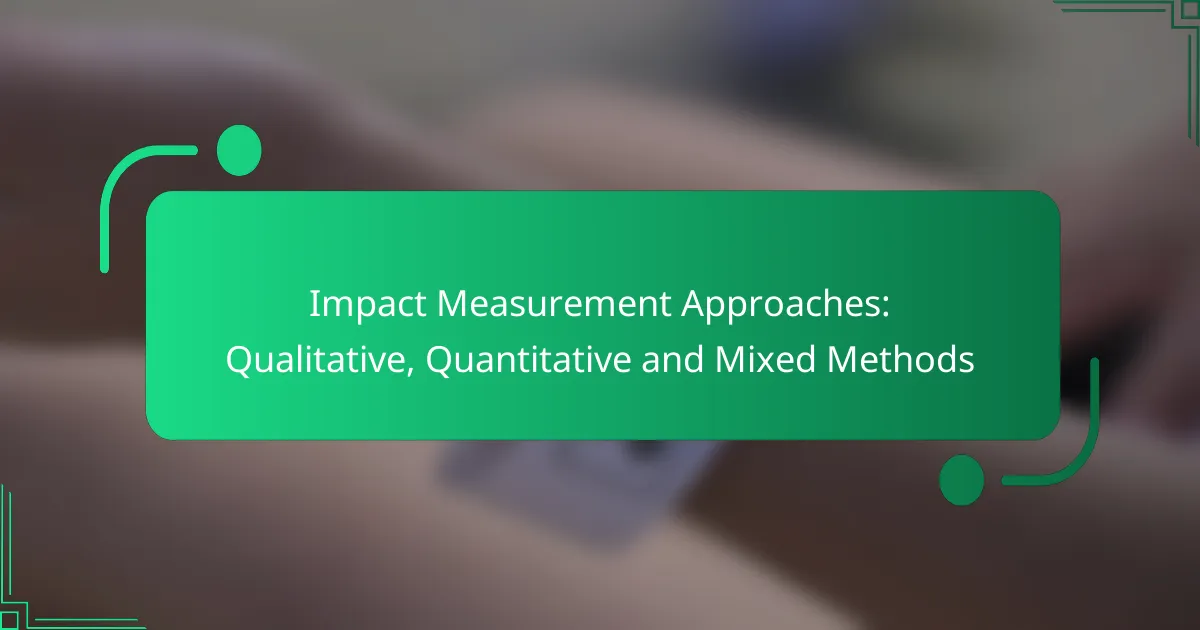Impact measurement approaches are essential for evaluating the effectiveness of programs and initiatives. Qualitative methods delve into the motivations and experiences behind outcomes, while quantitative methods focus on numerical data for objective analysis. By employing mixed methods, organizations can harness the strengths of both approaches, leading to a more comprehensive understanding of their impact.

What are the qualitative impact measurement approaches?
Qualitative impact measurement approaches focus on understanding the underlying reasons, motivations, and experiences behind outcomes. These methods provide rich, detailed insights that can complement quantitative data, helping organizations grasp the full impact of their initiatives.
Case studies
Case studies involve an in-depth exploration of a particular instance or example within a real-world context. They allow researchers to analyze complex issues and draw conclusions based on detailed observations. When conducting case studies, it’s essential to select representative examples that illustrate broader trends or impacts.
Consider documenting the context, challenges faced, and outcomes achieved. This approach can be particularly useful in sectors like education or healthcare, where individual experiences can highlight systemic issues.
Interviews
Interviews are direct conversations with stakeholders, beneficiaries, or experts to gather personal insights and experiences. They can be structured, semi-structured, or unstructured, depending on the depth of information required. Open-ended questions often yield richer data, allowing respondents to express their thoughts freely.
When conducting interviews, ensure a comfortable environment to encourage honest responses. Recording and transcribing interviews can help in analyzing the data effectively while maintaining accuracy.
Focus groups
Focus groups consist of guided discussions among a small group of participants, typically ranging from six to twelve individuals. This method encourages interaction and can reveal diverse perspectives on a specific topic. Facilitators should create a safe space for participants to share their views openly.
When organizing focus groups, consider the composition of participants to ensure a mix of opinions. Analyzing group dynamics can provide insights into community attitudes and social norms that influence outcomes.
Participant observation
Participant observation involves immersing oneself in the environment being studied, allowing researchers to observe behaviors and interactions firsthand. This method can reveal nuances that surveys or interviews might miss. It’s crucial to balance involvement with objectivity to avoid bias in observations.
Documenting experiences through field notes can enhance the richness of the data collected. This approach is particularly effective in community development projects, where understanding local culture is vital.
Content analysis
Content analysis entails systematically examining various forms of communication, such as documents, social media posts, or media articles, to identify patterns and themes. This method can quantify qualitative data by categorizing information into meaningful segments.
When conducting content analysis, define clear criteria for what to analyze and how to categorize findings. This approach can be beneficial in assessing public sentiment or evaluating the effectiveness of communication strategies.

What are the quantitative impact measurement approaches?
Quantitative impact measurement approaches focus on collecting and analyzing numerical data to assess the effectiveness of programs or interventions. These methods provide measurable evidence of impact, allowing for objective comparisons and informed decision-making.
Surveys
Surveys are a common quantitative method used to gather data from a specific population. They typically consist of structured questions that can be answered with numerical values, enabling easy statistical analysis. Surveys can be conducted online, via telephone, or in person, depending on the target audience and resources available.
When designing surveys, it’s crucial to ensure questions are clear and unbiased. Using a mix of closed-ended and scaled questions can yield richer data. Aim for a sample size that is statistically significant to enhance the reliability of your findings.
Statistical analysis
Statistical analysis involves applying mathematical techniques to interpret quantitative data. This can include descriptive statistics, such as means and medians, as well as inferential statistics, which help determine relationships and causality. Understanding the right statistical methods is key to drawing valid conclusions from your data.
Common statistical tools include regression analysis, t-tests, and ANOVA. Selecting the appropriate method depends on your research question and data type. Ensure you have a solid understanding of statistical principles to avoid misinterpretation of results.
Experimental designs
Experimental designs are structured approaches that involve manipulating one or more variables to observe the effect on a dependent variable. This method is often used in controlled environments to establish causality. Randomized controlled trials (RCTs) are a prime example, where participants are randomly assigned to treatment or control groups.
When implementing experimental designs, consider ethical implications and practical feasibility. Ensure that the sample size is adequate to detect significant differences, and maintain strict control over external variables to enhance the validity of your findings.
Longitudinal studies
Longitudinal studies track the same subjects over an extended period, allowing researchers to observe changes and trends over time. This approach is particularly useful for understanding long-term impacts and causal relationships. Data can be collected at multiple points to provide a comprehensive view of the subject’s evolution.
While longitudinal studies can yield rich insights, they require significant time and resources. Be prepared for potential challenges such as participant dropout and changes in external conditions that may affect results. Consistency in data collection methods is essential for reliable comparisons.
Data analytics
Data analytics involves using software tools to analyze large datasets for patterns and insights. This approach can include techniques such as data mining, predictive analytics, and machine learning. By leveraging advanced analytics, organizations can uncover trends that may not be immediately apparent through traditional methods.
When utilizing data analytics, ensure you have access to high-quality data and the right analytical tools. Familiarize yourself with data visualization techniques to effectively communicate findings. Additionally, consider the ethical implications of data usage, particularly regarding privacy and consent.

What are the mixed methods for impact measurement?
Mixed methods for impact measurement combine qualitative and quantitative approaches to provide a comprehensive understanding of a program’s effects. This methodology allows researchers to leverage the strengths of both types of data, offering richer insights and more robust conclusions.
Combining qualitative and quantitative
Combining qualitative and quantitative methods involves integrating numerical data with descriptive insights to enhance the evaluation process. For instance, a program might collect survey data (quantitative) alongside interviews or focus groups (qualitative) to explore participant experiences. This approach can reveal patterns in the data while also providing context and depth to the findings.
When using this combination, consider the timing of data collection and the methods of analysis. Ensure that both types of data inform each other, leading to a more nuanced understanding of the impact. Common pitfalls include neglecting one data type or failing to connect findings meaningfully.
Sequential exploratory design
Sequential exploratory design is a mixed methods approach where qualitative data is collected first, followed by quantitative data. This design is useful for developing hypotheses or instruments based on initial qualitative findings. For example, interviews may reveal themes that can be tested through a subsequent survey.
Key steps include clearly defining the qualitative phase objectives, conducting thorough qualitative analysis, and then designing quantitative instruments that reflect the insights gained. This method can be particularly effective in contexts where little prior research exists, allowing for a more tailored approach to measurement.
Concurrent triangulation design
Concurrent triangulation design involves collecting qualitative and quantitative data simultaneously to compare and validate findings. This approach enhances the credibility of results by corroborating evidence from different sources. For example, a program might conduct a survey while also holding focus groups to gather diverse perspectives on the same issue.
When implementing this design, ensure that both data sets are analyzed independently and then integrated to draw comprehensive conclusions. Be mindful of potential discrepancies between the two data types, as they can provide valuable insights into differing viewpoints or experiences. This method is particularly effective in complex evaluations where multiple factors influence outcomes.

How to choose the right impact measurement approach?
Selecting the appropriate impact measurement approach involves aligning your project goals with stakeholder needs and available resources. Consider whether qualitative, quantitative, or mixed methods best suit your objectives and context.
Assessing project goals
Begin by clearly defining your project goals. Are you aiming to understand user experiences, measure outcomes, or evaluate effectiveness? Qualitative methods are ideal for exploring perceptions, while quantitative approaches excel in measuring specific outcomes.
For instance, if your goal is to assess customer satisfaction, qualitative interviews may provide deep insights, whereas surveys can quantify satisfaction levels across a larger population. Balancing these methods can enhance your overall understanding.
Understanding stakeholder needs
Engage with stakeholders to identify their information requirements. Different stakeholders may prioritize different aspects of impact measurement; funders might seek quantitative data for accountability, while beneficiaries might value qualitative insights into their experiences.
Conducting stakeholder interviews or surveys can help clarify these needs. This understanding will guide your choice of methods, ensuring that the selected approach resonates with those who matter most to your project.
Evaluating resource availability
Assess the resources at your disposal, including time, budget, and expertise. Quantitative methods often require more resources for data collection and analysis, while qualitative methods can be more flexible and less resource-intensive.
For example, if your budget is limited, consider using online surveys for quantitative data collection, which can be cost-effective. Conversely, if you have access to skilled interviewers, qualitative methods may provide richer insights without significant financial investment.
